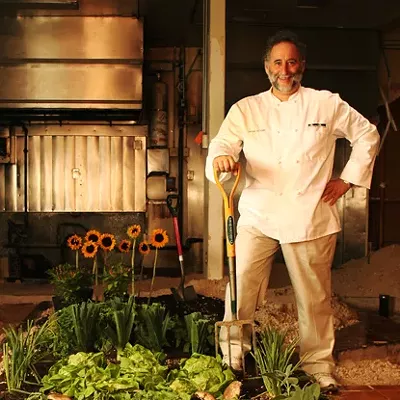It was affordable enough. The Chepe train, one of the American-owned lines that goes through the canyon, costs $100 for an adult and $50 for a child. For folks looking for a ritzier deal, the American Orient Express (see sidebar) offers experiences from $2,890 for a sleeper in the vintage pullman to $5,290 in the presidential suite, all meals included.
On that Saturday in December, we took the Amtrak train to El Paso, followed by a bus ride to Chihuahua City before we caught the Chepe train through the Copper Canyon.
The ride on Amtrak's Sunset Limited, through the desert Southwest to El Paso, brought a mix of folks--a lady from Shanghai, a mother and her kids making new lives in Missouri and a teenage boy on his way home from Sacramento for Christmas in Arkansas.
There wasn't a single taxi at the train station in El Paso to take us over to the border, so we lugged our bags a couple blocks toward the bus station, where we finally caught a cab.
The five-hour Juarez-Chihuahua bus ride cost $34. The bus departed the station within five minutes of our ticket purchase.
IN CHIHUAHUA, WE stayed at the El Coronado Hotel, for $14 a night with two big beds, balconies overlooking the streets, good hot water and a friendly elderly fellow running the front desk.
Chihuahua City is where Anthony Quinn was born. The 300-year-old city, located 210 miles south of Juarez by the Mexico's federal Highway 45, honors the recently deceased actor with a big statue overlooking the old Spanish-style buildings.
I hadn't been to Chihuahua City in four years, and I was struck by the remarkable number of American-owned factories that had been built. People seemed to be reinvigorated, hustling everywhere. It was like a light bulb had been switched on.
The emergence of the Mexican middle class is what's making it safe for Americans now. The economic gains for the average Mexican family, bolstered by the North American Free Trade Agreement, have made Mexico safer and better for visitors because of a reduction in desperation.
Monday morning, we arrived at the dark, chilly Chihuahua train station before 6 a.m. The taxi ride cost 30 pesos. The Yankee dollar gets about 10 pesos these days.
In the chill and darkness, Chihuahua passed by, lit only by city lights. Dawn began with an inexorable hint of illumination as the countryside came into focus. Besides Abe and me, there were Europeans on board and a few Mexican businessmen.
An hour into the journey, we had a Chihuahua-style omelet, along with coffee and orange juice in the well-appointed dining car.
By the time our breakfast was finished, the bright countryside, looking like Wyoming, slipped by through arroyos adjacent to haciendas with bird nests in the trees. We even went through an apple-growing region. Trucks hustled abundantly down the adjacent highway, sometimes paralleling the train.
The last hour before the town of Creel, the main wilderness hikers' jumping-off point at the top of the Copper Canyon, the country turned alpine. The highest point on the journey is nearly 8,000 feet, and in December, the temperature fell below freezing every night. We could feel the thin air as our breathing became more frequent.
Cashier Phillepe Vargas, the train's English-speaking friendly guy, said many of the travelers on the train are Americans, along with Spanish, Italian, English and German guests. The busiest time of year is May.
Abe and I mutually decided against getting off the 11 a.m. train for an overnight adventure at Creel, despite recommendations from hotel owners and restaurant occupants in Chihuahua. Creel is the acknowledged jumping-off place for travel and hiking into the Sierra Madre, one of Mexico's largest wilderness areas. The mythical Sierra Madre is where the famous line in Treasure of Sierra Madre was uttered by a bandito posing as a Federale: "Badges? We don't need no stinkin' badges."
We reached Divisadero around noon, where the Tarahumara sell their carvings, jewelry and wares against the splendid open-canyon backdrop.
The train coming up from Los Mochis meets the Chihuahua train at Divisadero each day. Some Chepe crew members swap trains and those that make their homes in Chihuahua or Los Mochis return home for the night. Others, like Phillepe, make the whole trip.
During the all-day train ride, we passed through 86 tunnels and across 37 bridges. Our original plan had been to take the ferry from Topolobampo (the coastal city a few miles from Los Mochis) across to La Paz, near the southern tip of the Baja Peninsula, where the whales were reputed to be passionately involved in mating rituals.
We learned of a thrice-weekly ferry from Guaymas to Santa Rosalia, located on the Baja Peninsula across the rippling Sea of Cortez and headed to catch it after a night in Los Mochis. Alas, when we arrived at Guaymas, we found that the ferry service had been suspended three weeks earlier, due to financial difficulties.
We got the crusty Hotel Impala at Guaymas for 160 pesos a night and found a couple of English stations on the cable television. Following a prawn dinner with Mariachi accompaniment at Los Barcos Restaurant--just around the corner on the waterfront--we walked along the embankment and saw a fisherman slinging in his catch, including a basket of small sharks.
We spent our remaining four Mexico days in gorgeous Guaymas and the adjacent marina and beach town of San Carlos.
The Copper Canyon train indeed provided a memorable time for an American father and his Australian son.









